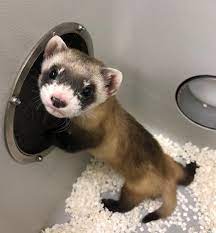Elizabeth Ann is now a year old, which is impressive for any Black-Footed Ferret but especially for her:the first endangered animal native to America ever to be cloned. She is still healthy, happy, and acts like a normal black-footed ferret. This means so much for the future of endangered animals including bears, wolves, coyotes, turtles and more.
--Calliope Dean, 6th grade

Elizabeth Ann is now a year old, which is impressive for any Black-Footed Ferret but especially for her:the first endangered animal native to America ever to be cloned. She is still healthy, happy, and acts like a normal black-footed ferret. This means so much for the future of endangered animals including bears, wolves, coyotes, turtles and more.
According to, New York Times: "Elizabeth Ann, The First Cloned Black Footed Ferret" By Sabrina Imbler,“Elizabeth Ann had just turned 21 days old — surely a milestone for any ferret but a particularly meaningful one for Elizabeth Ann, the first of any native, endangered animal species in North America to be cloned."
According to, New York Times: "Elizabeth Ann, The First Cloned Black Footed Ferret" By Sabrina Imbler,“Elizabeth Ann had just turned 21 days old — surely a milestone for any ferret but a particularly meaningful one for Elizabeth Ann, the first of any native, endangered animal species in North America to be cloned."
Scientists used a deceased Black Footed Ferret so they could enter its cell into a regular ferret. According to the same New York Times article,“The Frozen Zoo sent Willa’s cryogenically preserved cell line to ViaGen’s lab in New York. ViaGen created embryos and implanted them into a domestic ferret surrogate. At day 14, an ultrasound confirmed heartbeats.”

Soon after Elizabeth Ann was born biological tests proved that she was indeed a Black-footed ferret. According to, “Elizabeth Ann an Endangered Ferret is Cloned”: News For Kids, “Blood tests have proven her to be 100% black-footed ferret. It’s the first native endangered species ever cloned in the US. Elizabeth Ann seems normal and healthy, and enjoys spending her days in the fake burrows in her cage.”
The article continues, “She won’t ever be released into the wild, but soon, she may have some cloned brothers and sisters. And later, she will probably have babies. Sooner or later, her children will have babies with wild black-footed ferrets, and her DNA will begin to spread.” Hopefully sooner or later the population will increase therefore keeping the black-footed ferrets safe from extinction. According to, New York Times article,“In the Frozen Zoo, the cells of long-dead creatures await their moment to come back to life”
There are many extinct and endangered species that could be saved by recent advancements in animal cloning. So many people in the future would be able to experience seeing foxes, bears, red pandas and more.
For More Information on this Topic Go To:
The article continues, “She won’t ever be released into the wild, but soon, she may have some cloned brothers and sisters. And later, she will probably have babies. Sooner or later, her children will have babies with wild black-footed ferrets, and her DNA will begin to spread.” Hopefully sooner or later the population will increase therefore keeping the black-footed ferrets safe from extinction. According to, New York Times article,“In the Frozen Zoo, the cells of long-dead creatures await their moment to come back to life”
There are many extinct and endangered species that could be saved by recent advancements in animal cloning. So many people in the future would be able to experience seeing foxes, bears, red pandas and more.
For More Information on this Topic Go To:
- Elizabeth Ann, the first cloned black-footed ferret video
- National Geographic: For More Information About Black Footed Ferrets




